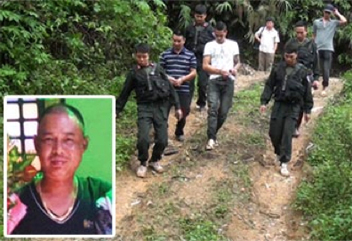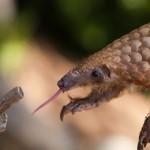By Scott Roberton, Wildlife Conservation Society

Stashed in the hidden compartments of container trucks, or concealed among waste plastic, seafood, and other products, live animals and animal parts traverse the globe. The cargo that gets unloaded into rickety boats on the Vietnam side of the Ka Long River includes wild tigers, elephant tusks, pangolins, rhino horns, and wild turtles.
These threatened species, many still tenuously alive, don’t have far to float—just ten meters across the river and into China to satisfy one of the world’s largest demand markets for wildlife products.
I have seen this firsthand. In collaboration with local partners, the Wildlife Conservation Society’s Vietnam program conducted hundreds of hours of surveys of trade in all products along the Ka Long River in Mong Cai City between October 2011 and January 2012. Our analysis found that over 90 percent of all products (both legal and illegal) traded in Mong Cai between Vietnam and China are passing through illegal crossings. In just those three months we witnessed close to 17,000 vehicles making nearly 34,000 shipments to and from China.
We discovered that the most commonly smuggled animals are pangolins (live, frozen, and de-scaled), freshwater hard-shell and soft-shell turtles, snakes (cobra, rat snakes, python), elephant ivory, crocodiles, civets, bears (live and paws), macaques, tokay geckos, rhino horn, and a number of bird species. The list includes a number of species that are protected nationally (in China and Vietnam) and those that are prohibited from international trade under the Convention on International Trade in Endangered Species (CITES). Some are also considered Endangered and Critically Endangered by the IUCN Red List.

Our Ka Long River data and other surveys have revealed a depressing conclusion -— the trade in wildlife in Vietnam is vast and is driving species to extinction.
Our studies also revealed that the organized criminal gangs that coordinate smuggling in Mong Cai have proliferated as a result of weak governance and corruption at some of the border authorities and law enforcement agencies. Criminal brokers who facilitate human and drug trafficking across the border also play critical roles in the illegal wildlife trade: They act as middlemen between Chinese buyers and Vietnamese traders and maintain close, corrupt relationships with law enforcement agencies to evade arrest, prosecution, and punishment.
As a result the enforcement dragnet has quite a loose mesh. Between 2006 and 2009, a mere 317 arrests were made for wild animal protection violations in Quang Ninh province where Mong Cai is located, and of those, only 14 were reportedly transferred for criminal prosecution, of which only a handful received heavy fines or jail terms.
Despite this morass of bad news, there are encouraging signs and reasons for hope.
First, the Vietnamese media has been doing a truly commendable job. Courageous journalists are generating stories about seizures on a regular basis, and they print commentaries and investigative articles on the state of the wildlife trade and smuggling in the Mong Cai region.

Second, the Vietnamese government has been taking notice. The prime minister of Vietnam, Nguyen Tan Dung, has issued directives to a range of ministries to tighten regulation of cross-border trade and take action against the organized smuggling groups.
This has led to the third and perhaps most encouraging action: The government of Vietnam recently took direct enforcement action against a major wildlife smuggling group in Mong Cai, including the capture and arrest of 20 members of “Steel-face” Dung’s syndicate, the most notorious and violent kingpin of wildlife (and other illegal) trade on the Vietnam-China border.
Yet more needs to be done.
While smuggling protected wildlife across international borders is a criminal offense in Vietnam, there are numerous repeat offenders who operate throughout the country’s provinces. If they’re caught, these smugglers pay fines that are relatively low compared to the amount of money they make—the maximum fine can be up to 500 million Vietnamese dong, or about $24,000. Smugglers usually pay tens of thousands of dollars in bribes to officials when shipping illegal wildlife over the border.

Eliminating the illegal cross-border wildlife trade is a difficult, years-long goal. The government should make it a priority to launch a sustained campaign to prevent corruption of border officials by seeking out and applying strong and effective punishments to anyone found taking bribes. Other recommendations include a rewards-based system for public reporting of corruption in the border trade, constructing barriers along the river, and installing vehicle X-ray scanners at some of the customs checkpoints in Mong Cai to increase detection rates.
We at the WCS Vietnam office have been working to reduce the illegal wildlife trade in this country for nearly a decade. We pursue this goal by rigorously documenting the scale and dynamics of the illegal wildlife trade, by sharing this information with government officials as well as many other agencies and individuals, by training more than 800 law enforcement officers in wildlife crime investigation and enforcement techniques, and by supporting bilateral dialogues between Vietnam and key trading countries.
We hope that by the end of our next decade of working collaboratively with the Vietnamese government we may celebrate an end to the widespread and pernicious trade in illegal wildlife.
Scott Roberton is country representative for the Wildlife Conservation Society‘s Vietnam Program.
| This article is licensed under a Creative Commons License. |





![Pangolin Trafficking: 2011 to August 2013 [Infographic]](https://annamiticus.com/wp-content/uploads/2013/08/PangolinsInTrade2011thruAugust2013-150x150.jpg)